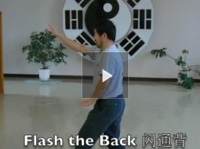- One must truly not move.
- This means one must have a centre, a centre line or a dot. This can be the centre line as a vertical stick which can rotate from the top as the non moving point.
- As the centre is established, then the two ends must be moved.
- When the two ends are moved, one`s producing a lever.
Vincent Den Hengst
https://www.facebook.com/100045708723702/videos/620073352470492/
Studying Chen Style Taijquan Practical Method as an anthropologist
As a trained and graduated anthropologist I am looking at the world through a different lens. Not a big deal, I do not overrate my academic knowledge to be of any benefit in general to the world. Though drawing upon my education many credits should go out to the Practical Method and not the least to its cultural Gatekeeper Master Chen Zhonghua (19th Generation International Standard Bearer), as a immensely sophisticated system of knowledge. My academic bachelor education prepared me for a learning research project to build my Masters` thesis upon. I would gather information methodologically, learn apply analytical tools, master theoretical reasoning based on facts in logical terms, excluding speculation and organising arguments thereof in historical and contemporary anthropological debates relevant to specific, relevant subjects. Read more
Three examples of Master Chen`s clarity of hands on explanation of certain types of dealing with energy taught me invaluable lessons. If the students follow instructions then all will be able to do things that will be amazing to themselves. By practice you build up not only martial skill but also health. From the beginning when we start to learn Practical Method we are trying to apply the most fundamental principle of taiji in partner exercises and push hands: the separation of yin and yang. Taijiquan is in my words in this context an effect on the opponent or partner by using taiji principles that spring from our understanding of the exact teachings of Master Chen Zhonghua and is defined by the stage of our practice.
In the weekend of 9 & 10 November Carlotta and Sven from Berlin came to Utrecht in the Netherlands for the Open Dutch Championship and a workshop.
Sven led the workshop and Carlotta the execution of the yilu 13 section. Two of my students in Holland, Lucas and Ester took part in it, together five of us. Read more
In 2015 I stayed one month at the Daqinshan Practical Method training centre of Master Chen’s. One evening training session Master Chen was explaining one of the facets of the importance of the Chen Style Tall Hand Posture during all your exercises (yilu, push hands and foundations unless stated otherwise). This account is my subjective view on what he explained and invite everyone to add their thoughts or to correct me, please.
Read more
My name is Vincent den Hengst. I am from the Netherlands, Utrecht, where I started practicing Hunyuan taiji under James Fletcher in 2007. From the beginning, I kept exercising daily. In 2013 I stepped over to Practical Method. In 2014 and 2015 I went to Daqinshan for two months in total and observed several workshops since 2013. I regard Practical Method taiji as taught by Grandmaster Chen as the highest possible region of martial art, so I feel lucky and happy I finalized my life’s queeste to find the one martial art.
Hereby some collected Practical Method logos from schools all over the world. If you have one logo and you don’t find it in this rough collection, got a better version or otherwise, please post it in the comments section or send it to me via wechat or by email vincent.denhengst@gmail.com and I will repost it later on. This collection is gathered in order to research the possibility of an international standard logo, as instigated by some elder taiji brothers of mine in the English Wechat group.
Read more
The richness of Chen Style Taijiquan Practical Method struck me in 2013 when I had my first encounter with Master Chen and his explanations. There is so much to learn for me. Master Chen told on several occasions, that if you think you know how to do practical method, you can stop to practice, cause you stop learning. There is always something that you don’t know, you can do better, you can improve, that takes time, that someone else knows or knows better … and so on.
At first, I was a bit disappointed. Read more
Workshop Practical Method Chen Style Taichi Quan push hands by Grandmaster Joseph Chen Zhonghua
De Glind 26-27april 2014, Netherlands
These notes are partly chronological and based on how I percieved them. I kept as close as I could to Master Chen’s exact words.
Day one
The workshop started with an introduction. Underlying the art of Practical Method Taiji Chen Style are thirteen dimensions. These thirteen dimensions are divided in two levels. Eight dimensions are related to the air; five are related to the floor.



